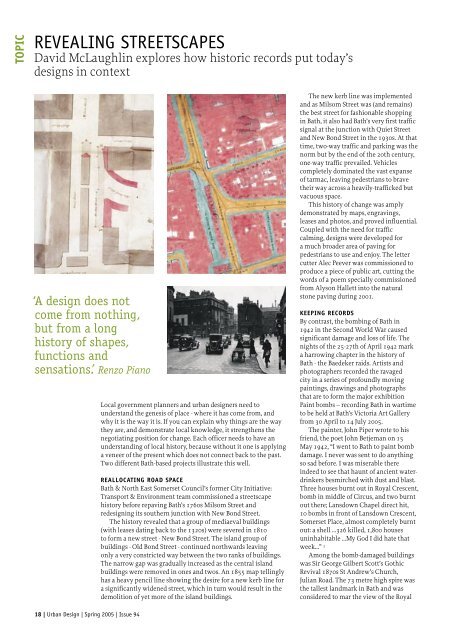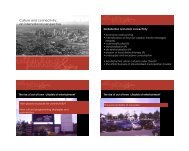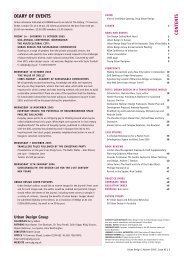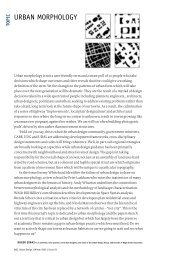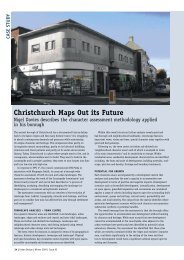CONTENTS DIARY OF EVENTS - The Urban Design Group
CONTENTS DIARY OF EVENTS - The Urban Design Group
CONTENTS DIARY OF EVENTS - The Urban Design Group
You also want an ePaper? Increase the reach of your titles
YUMPU automatically turns print PDFs into web optimized ePapers that Google loves.
TOPIC<br />
REVEALING STREETSCAPES<br />
David McLaughlin explores how historic records put today’s<br />
designs in context<br />
‘A design does not<br />
come from nothing,<br />
but from a long<br />
history of shapes,<br />
functions and<br />
sensations.’ Renzo Piano<br />
18 | <strong>Urban</strong> <strong>Design</strong> | Spring 2005 | Issue 94<br />
Local government planners and urban designers need to<br />
understand the genesis of place - where it has come from, and<br />
why it is the way it is. If you can explain why things are the way<br />
they are, and demonstrate local knowledge, it strengthens the<br />
negotiating position for change. Each officer needs to have an<br />
understanding of local history, because without it one is applying<br />
a veneer of the present which does not connect back to the past.<br />
Two different Bath-based projects illustrate this well.<br />
REALLOCATING ROAD SPACE<br />
Bath & North East Somerset Council’s former City Initiative:<br />
Transport & Environment team commissioned a streetscape<br />
history before repaving Bath’s 1760s Milsom Street and<br />
redesigning its southern junction with New Bond Street.<br />
<strong>The</strong> history revealed that a group of mediaeval buildings<br />
(with leases dating back to the 1320s) were severed in 1810<br />
to form a new street - New Bond Street. <strong>The</strong> island group of<br />
buildings - Old Bond Street - continued northwards leaving<br />
only a very constricted way between the two ranks of buildings.<br />
<strong>The</strong> narrow gap was gradually increased as the central island<br />
buildings were removed in ones and twos. An 1855 map tellingly<br />
has a heavy pencil line showing the desire for a new kerb line for<br />
a significantly widened street, which in turn would result in the<br />
demolition of yet more of the island buildings.<br />
<strong>The</strong> new kerb line was implemented<br />
and as Milsom Street was (and remains)<br />
the best street for fashionable shopping<br />
in Bath, it also had Bath’s very first traffic<br />
signal at the junction with Quiet Street<br />
and New Bond Street in the 1930s. At that<br />
time, two-way traffic and parking was the<br />
norm but by the end of the 20th century,<br />
one-way traffic prevailed. Vehicles<br />
completely dominated the vast expanse<br />
of tarmac, leaving pedestrians to brave<br />
their way across a heavily-trafficked but<br />
vacuous space.<br />
This history of change was amply<br />
demonstrated by maps, engravings,<br />
leases and photos, and proved influential.<br />
Coupled with the need for traffic<br />
calming, designs were developed for<br />
a much broader area of paving for<br />
pedestrians to use and enjoy. <strong>The</strong> letter<br />
cutter Alec Peever was commissioned to<br />
produce a piece of public art, cutting the<br />
words of a poem specially commissioned<br />
from Alyson Hallett into the natural<br />
stone paving during 2001.<br />
KEEPING RECORDS<br />
By contrast, the bombing of Bath in<br />
1942 in the Second World War caused<br />
significant damage and loss of life. <strong>The</strong><br />
nights of the 25-27th of April 1942 mark<br />
a harrowing chapter in the history of<br />
Bath - the Baedeker raids. Artists and<br />
photographers recorded the ravaged<br />
city in a series of profoundly moving<br />
paintings, drawings and photographs<br />
that are to form the major exhibition<br />
Paint bombs – recording Bath in wartime<br />
to be held at Bath’s Victoria Art Gallery<br />
from 30 April to 14 July 2005.<br />
<strong>The</strong> painter, John Piper wrote to his<br />
friend, the poet John Betjeman on 15<br />
May 1942, “I went to Bath to paint bomb<br />
damage. I never was sent to do anything<br />
so sad before. I was miserable there<br />
indeed to see that haunt of ancient waterdrinkers<br />
besmirched with dust and blast.<br />
Three houses burnt out in Royal Crescent,<br />
bomb in middle of Circus, and two burnt<br />
out there; Lansdown Chapel direct hit,<br />
10 bombs in front of Lansdown Crescent,<br />
Somerset Place, almost completely burnt<br />
out: a shell …326 killed, 1,800 houses<br />
uninhabitable …My God I did hate that<br />
week…” 1<br />
Among the bomb-damaged buildings<br />
was Sir George Gilbert Scott’s Gothic<br />
Revival 1870s St Andrew’s Church,<br />
Julian Road. <strong>The</strong> 73 metre high spire was<br />
the tallest landmark in Bath and was<br />
considered to mar the view of the Royal


